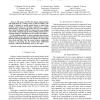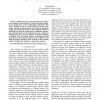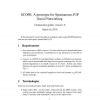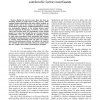PERCOM
2010
ACM
14 years 7 months ago
2010
ACM
122
Voted
PERCOM
2010
ACM
14 years 7 months ago
2010
ACM
The automatic and unobtrusive identification of user's activities is one of the challenging goals of context-aware computing. This paper discusses and experimentally evaluate...
153
Voted
PERCOM
2010
ACM
14 years 7 months ago
2010
ACM
Abstract-- Mobile devices are becoming increasingly powerful with regards to processing speed, networking capabilities, storage capacity etc. While these improvements open up new p...
PERCOM
2010
ACM
14 years 7 months ago
2010
ACM
A new context management framework, which supports the interaction between different domain context managers, is proposed. Two different context producerconsumer patterns are defin...
172
click to vote
PERCOM
2010
ACM
14 years 7 months ago
2010
ACM
In this paper, we propose an algorithm to estimate 2D shapes and positions of obstacles such as buildings using GPS and wireless communication history of mobile nodes. Our algorith...
PERCOM
2010
ACM
14 years 10 months ago
2010
ACM
This paper describes the design, implementation and deployment of a wireless sensor system for athletes. The system is designed to profile sprints based on input from on-body senso...
113
Voted
PERCOM
2010
ACM
14 years 10 months ago
2010
ACM
Mobile peer-to-peer groups, which do not require any pre-deployed infrastructure or trusted centralized authority are valuable for a variety of collaborative applications. This wor...
PERCOM
2010
ACM
14 years 10 months ago
2010
ACM
110
Voted
PERCOM
2010
ACM
14 years 10 months ago
2010
ACM
During the last few years there has been an increasing number of people-centric sensing projects, which combine location information with other sensors available on mobile devices,...
128
click to vote
PERCOM
2010
ACM
14 years 10 months ago
2010
ACM
In autonomic networks, the self-configuration of network entities is one of the most desirable properties. In this paper, we show how formal verification techniques can verify the ...




